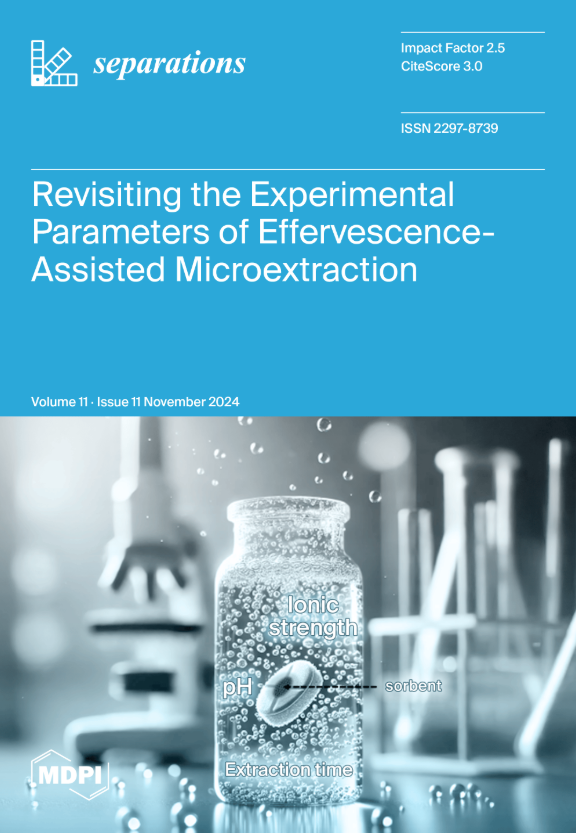A Cyanoalkyl Silicone GC Stationary-Phase Polymer as an Extractant for Dispersive Liquid–Liquid Microextraction
IF 2.7
4区 工程技术
Q3 CHEMISTRY, ANALYTICAL
引用次数: 0
Abstract
In this work, three cyanoalkyl silicone GC stationary-phase polymers, namely OV-105, OV-225, and OV-275, were investigated as potential extractants for dispersive liquid–liquid microextraction (DLLME). The OV-225 polymer (cyanopropylmethyl-phenylmethylsilicone) exhibited the cleanest chromatographic background and was extensively studied. The proposed polymer was tested through the DLLME of four non-steroidal anti-inflammatory drugs from aqueous samples, followed by HPLC separation with UV detection at 230 nm. To achieve the maximum enrichment, the experimental conditions that influence the DLLME process were optimized using one-factor-at-a-time and design-of-experiment (DoE) approaches. The extraction variables (polymer mass, dispersive solvent volume, buffer pH, and mixing time) were screened by implementing a two-level full factorial design (FFD). Significant variables were fine-tuned using response surface methodology based on a face-centered central composite design (CCD). The optimum conditions were 10 mg of polymer (extraction medium); 50 µL of tetrahydrofuran (dispersive solvent); 100 µL of phosphate buffer pH 2.75 ([PO43−] = 100 mM); and 3 min of vortex mixing. The addition of salt had a minimal effect on the enrichment factors. In the optimum conditions, enrichment factors up to 46 were achieved using 1.5 mL samples. Calibration curves exhibited correlation coefficients > 0.999 using 4-pentylbenzoic acid as an internal standard. The limits of quantitation were 5 ng/mL for naproxen, 10 ng/mL for diflunisal, 25 ng/mL for indomethacin, and 75 ng/mL for ibuprofen. The analysis of spiked tap water samples showed adequate relative recoveries and precision. In conclusion, the proposed polymer (OV-225) is a potential greener alternative to traditional organic extractants used in DLLME.用作分散液-液微萃取萃取剂的氰烷基硅 GC 固定相聚合物
本研究将 OV-105、OV-225 和 OV-275 三种氰烷基有机硅 GC 固定相聚合物作为分散液-液微萃取 (DLLME) 的潜在萃取剂进行了研究。OV-225 聚合物(氰丙基甲基苯基甲基硅氧烷)的色谱背景最为干净,因此得到了广泛的研究。通过从水样中对四种非甾体抗炎药物进行 DLLME 测试,然后在 230 纳米波长处进行 HPLC 分离和紫外检测。为了达到最大的富集效果,我们采用单因素法和实验设计法(DoE)对影响 DLLME 过程的实验条件进行了优化。通过实施两级全因子设计(FFD),对萃取变量(聚合物质量、分散溶剂体积、缓冲液 pH 值和混合时间)进行了筛选。在面心中心复合设计(CCD)的基础上,采用响应面方法对重要变量进行了微调。最佳条件为:10 毫克聚合物(萃取介质);50 微升四氢呋喃(分散溶剂);100 微升 pH 值为 2.75 的磷酸盐缓冲液([PO43-] = 100 毫摩尔);涡旋搅拌 3 分钟。盐的添加对富集因子的影响很小。在最佳条件下,1.5 mL 样品的富集因子可达 46。以 4-戊基苯甲酸为内标,校准曲线的相关系数大于 0.999。萘普生的定量限为 5 纳克/毫升,双氟尼沙的定量限为 10 纳克/毫升,吲哚美辛的定量限为 25 纳克/毫升,布洛芬的定量限为 75 纳克/毫升。对加标自来水样品的分析显示出足够的相对回收率和精密度。总之,所提议的聚合物(OV-225)是 DLLME 中使用的传统有机萃取剂的潜在绿色替代品。
本文章由计算机程序翻译,如有差异,请以英文原文为准。
求助全文
约1分钟内获得全文
求助全文
来源期刊

Separations
Chemistry-Analytical Chemistry
CiteScore
3.00
自引率
15.40%
发文量
342
审稿时长
12 weeks
期刊介绍:
Separations (formerly Chromatography, ISSN 2227-9075, CODEN: CHROBV) provides an advanced forum for separation and purification science and technology in all areas of chemical, biological and physical science. It publishes reviews, regular research papers and communications. Our aim is to encourage scientists to publish their experimental and theoretical results in as much detail as possible. There is no restriction on the length of the papers. The full experimental details must be provided so that the results can be reproduced. There are, in addition, unique features of this journal:
Manuscripts regarding research proposals and research ideas will be particularly welcomed.
Electronic files and software regarding the full details of the calculation and experimental procedure, if unable to be published in a normal way, can be deposited as supplementary material.
Manuscripts concerning summaries and surveys on research cooperation and projects (that are funded by national governments) to give information for a broad field of users.
The scope of the journal includes but is not limited to:
Theory and methodology (theory of separation methods, sample preparation, instrumental and column developments, new separation methodologies, etc.)
Equipment and techniques, novel hyphenated analytical solutions (significantly extended by their combination with spectroscopic methods and in particular, mass spectrometry)
Novel analysis approaches and applications to solve analytical challenges which utilize chromatographic separations as a key step in the overall solution
Computational modelling of separations for the purpose of fundamental understanding and/or chromatographic optimization
 求助内容:
求助内容: 应助结果提醒方式:
应助结果提醒方式:


